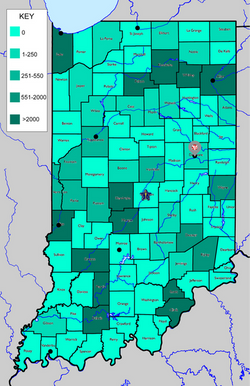Indiana ranked No. 30 out of the 50 states in water quality, according to a 2015 report by WalletHub.
However, Delaware County’s water quality does not reflect Indiana’s overall ranking.
According to the Environmental Working Group’s National Water Database, Delaware County has had no water violations since 2004.
Many factors have contributed to the quality of Muncie’s water, and those factors start at the water sources themselves.
The White River and the Prairie Creek Reservoir are the two main sources of Muncie’s water. These sources are both considered surface water since they are above ground. There are also several wells that are considered ground water.
Ball State Assistant Professor of Geology Lee Florea says that the difference in ground water and surface water when it comes to water quality depends on location.
“Surface water and ground water have completely different chemistries around the nation depending upon what the underlying soils and geology are like,” said Florea.
The water sources in Muncie have had a long history of being polluted and trash-ridden. It was not until 1972 when Ball State graduate John Craddock created the Bureau of Water Quality under the Muncie Sanitary District.
According to the Muncie Sanitary District, the Bureau of Water Quality is “one of the oldest local water pollution testing and enforcement agencies in the United States.”
Craddock, who is now Director Emeritus for the bureau, began researching the White River’s quality while he was getting his degree at Ball State.
He found that the river was so highly polluted that there were almost no life forms and the river was thick with industrial waste, according to his reports.
Through Craddock and the Bureau of Water Quality’s efforts, 98 percent of toxic metal pollution has been reduced, along with new sewer lines put in place to avoid raw sewage run-off in the river.
Cleaning the water sources is not enough to provide for quality drinking water. While the Muncie Sanitary District is responsible for treating and monitoring wastewater and local streams and rivers, the drinking water is actually provided by Indiana-American Water Company, according to Rick Conrad, director of the Muncie Sanitary District.
Indiana-American Water Company supplies an average of 7.7 million gallons of water each day to the residents of Muncie, according to their water quality information charts for Muncie.
The company uses several processes to clean the water before it is pumped to homes and businesses for use. Settling tanks, sand filters and chlorine are all used to clean and filter the water to make it safe for human consumption.
The wastewater that is sent out of homes travels through a main sewer pipe that is then sent through another treatment process at the Muncie Wastewater Treatment Plant on Kilgore Avenue.
This stage in the treatment process is to ensure that the water going back into the White River is not contaminated.
The Wastewater Treatment Plant filters and cleans the water in three stages before it is discharged back into the river: primary, secondary and tertiary.
The primary stage involves using screens to filter large pieces of debris from the wastewater.
The secondary stage is a more biological process, where microorganisms are put in to the water to feed on the bacteria and clean the water.
The final stage is the final filtering and disinfecting process before the water is discharged into the White River to begin the process all over again.
While the many treatment processes have improved the quality of Muncie’s water, community involvement has also been an important component in keeping the White River aesthetically clean.
Over the past nine years, the White River Cleanup has been using volunteers from the community to remove over 85,000 pounds of trash and over 600 tires from the river.
Efforts through the many facets of these water systems have provided Muncie with clean, quality water and will continue to provide those same services in the future to keep the waterways clean.
Water quality in Muncie
above state ranking
With the water crisis in Flint, Michigan in the backs of people’s minds, many cities and states have taken a look at the quality of their drinking water to see if what happened in Flint could potentially happen in other cities as well.
 Water Sources |  Slideshow |
|---|---|
 Timeline |  Water Sources |
 Indiana Drinking Water Violations |